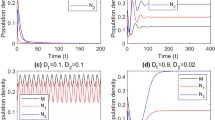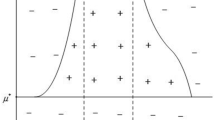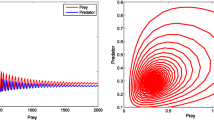Abstract
In ecology, the refuge protection of the prey plays a significant role in the dynamics of the interactions between prey and predator. In this paper, we investigate the dynamics of a non-smooth prey–predator mathematical model characterized by density-dependent intermittent refuge protection of the prey. The model assumes the population density of the predator as an index for the prey to decide on when to avail or discontinue refuge protection, representing the level of apprehension of the prey by the predators. We apply Filippov’s regularization approach to study the model and obtain the sliding segment of the system. We obtain the criterion for the existence of the regular or virtual equilibria, boundary equilibrium, tangent points, and pseudo-equilibria of the Filippov system. The conditions for the visibility (or invisibility) of the tangent points are derived. We investigate the regular or virtual equilibrium bifurcation, boundary-node bifurcation and pseudo-saddle-node bifurcation. Further, we examine the effects of dispersal delay on the Filippov system associated with prey vigilance in identifying the predator population density. We observe that the hysteresis in the Filippov system produces stable limit cycles around the predator population density threshold in some bounded region in the phase plane. Moreover, we find that the level of apprehension and vigilance of the prey play a significant role in their refuge-dispersion dynamics.











Similar content being viewed by others
Availability of data and material
Not applicable.
Code availability
Not applicable.
References
Amo, L., López, P., Martín, J.: Refuge use: a conflict between avoiding predation and losing mass in lizards. Physiol. Behav. 90(2–3), 334–343 (2007)
Beauchamp, G.: What can vigilance tell us about fear? Animal Sent. 2(15), 1 (2017)
Beauchamp, G.: External body temperature and vigilance to a lesser extent track variation in predation risk in domestic fowls. BMC Zool. 4(1), 1–8 (2019)
Belgrad, B.A., Griffen, B.D.: Predator-prey interactions mediated by prey personality and predator hunting mode. Proc. R. Soc. B Biol. Sci. 283(1828), 20160408 (2016)
Berezovskaya, F.S., Song, B., Castillo-Chavez, C.: Role of prey dispersal and refuges on predator-prey dynamics. SIAM J. Appl. Math. 70(6), 1821–1839 (2010)
Bhattacharyya, J., Roelke, D.L., Pal, S., Banerjee, S.: Sliding mode dynamics on a prey-predator system with intermittent harvesting policy. Nonlinear Dyn. 98(2), 1299–1314 (2019)
Bhattacharyya, J., Roelke, D.L., Walton, J.R., Banerjee, S.: Using \(yy\) supermales to destabilize invasive fish populations. Theor. Popul. Biol. 134, 1–14 (2020)
Blake, C.A., Andersson, M.L., Hulthén, K., Nilsson, P.A., Brönmark, C.: Conspecific boldness and predator species determine predation-risk consequences of prey personality. Behav. Ecol. Sociobiol. 72(8), 133 (2018)
Boukal, D.S., et al.: Lyapunov functions for Lotka–Volterra predator-prey models with optimal foraging behavior. J. Math. Biol. 39(6), 493–517 (1999)
Brown, G.E., Rive, A.C., Ferrari, M.C., Chivers, D.P.: The dynamic nature of antipredator behavior: prey fish integrate threat-sensitive antipredator responses within background levels of predation risk. Behav. Ecol. Sociobiol. 61(1), 9–16 (2006)
Carthey, A.J., Bucknall, M.P., Wierucka, K., Banks, P.B.: Novel predators emit novel cues: a mechanism for prey naivety towards alien predators. Sci. Rep. 7(1), 1–9 (2017)
Chattopadhyay, J., Bairagi, N., Sarkar, R.: A predator-prey model with some cover on prey species. Nonlinear Phenom. Complex Syst. Minsk 3(4), 407–420 (2000)
Chen, L., Chen, F., Chen, L.: Qualitative analysis of a predator-prey model with holling type ii functional response incorporating a constant prey refuge. Nonlinear Anal. Real World Appl. 11(1), 246–252 (2010)
Chittka, L., Skorupski, P., Raine, N.E.: Speed-accuracy tradeoffs in animal decision making. Trends Ecol. Evolut. 24(7), 400–407 (2009)
Choh, Y., Ignacio, M., Sabelis, M.W., Janssen, A.: Predator-prey role reversals, juvenile experience and adult antipredator behaviour. Sci. Rep. 2, 728 (2012)
Cooper, W.E., Jr., Perez-Mellado, V.: Historical influence of predation pressure on escape by podarcis lizards in the Balearic islands. Biol. J. Lin. Soc. 107(2), 254–268 (2012)
Donelan, S.C., Grabowski, J.H., Trussell, G.C.: Refuge quality impacts the strength of nonconsumptive effects on prey. Ecology 98(2), 403–411 (2017)
Dowling, L.M., Godin, J.G.J.: Refuge use in a killifish: influence of body size and nutritional state. Can. J. Zool. 80(4), 782–788 (2002)
Drakunov, S.V., Utkin, V.I.: Sliding mode control in dynamic systems. Int. J. Control 55(4), 1029–1037 (1992)
Fardell, L.L., Pavey, C.R., Dickman, C.R.: Fear and stressing in predator-prey ecology: considering the twin stressors of predators and people on mammals. PeerJ 8, e9104 (2020)
Feyten, L.E., Brown, G.E.: Ecological uncertainty influences vigilance as a marker of fear. Animal Sent. 2(15), 7 (2018)
Filippov, A.F.: Differential Equations with Discontinuous Righthand Sides: Control Systems, vol. 18. Springer, Berlin (2013)
Filippova, T.: A note on the evolution property of the assembly of viable solutions to a differential inclusion. Comput. Math. Appl. 25(2), 115–121 (1993)
Hauzy, C., Gauduchon, M., Hulot, F.D., Loreau, M.: Density-dependent dispersal and relative dispersal affect the stability of predator-prey metacommunities. J. Theor. Biol. 266(3), 458–469 (2010)
Jana, D., Ray, S.: Impact of physical and behavioral prey refuge on the stability and bifurcation of Gause type Filippov prey-predator system. Model. Earth Syst. Environ. 2(1), 24 (2016)
Jeffrey, M.R.: Dynamics at a switching intersection: hierarchy, isonomy, and multiple sliding. SIAM J. Appl. Dyn. Syst. 13(3), 1082–1105 (2014)
Ji, L., Wu, C.: Qualitative analysis of a predator-prey model with constant-rate prey harvesting incorporating a constant prey refuge. Nonlinear Anal. Real World Appl. 11(4), 2285–2295 (2010)
Kar, T.K.: Modelling and analysis of a harvested prey-predator system incorporating a prey refuge. J. Comput. Appl. Math. 185(1), 19–33 (2006)
Kavaliers, M., Choleris, E.: Antipredator responses and defensive behavior: ecological and ethological approaches for the neurosciences. Neurosci. Biobehav. Rev. 25(7–8), 577–586 (2001)
Křivan, V.: Behavioral refuges and predator-prey coexistence. J. Theor. Biol. 339, 112–121 (2013)
Manarul Haque, M., Sarwardi, S.: Dynamics of a harvested prey-predator model with prey refuge dependent on both species. Int. J. Bifurc. Chaos 28(12), 1830040 (2018)
Martin, R.A., Hammerschlag, N.: Marine predator-prey contests: ambush and speed versus vigilance and agility. Mar. Biol. Res. 8(1), 90–94 (2012)
Mirza, R.S., Ferrari, M.C., Kiesecker, J.M., Chivers, D.P.: Responses of American toad tadpoles to predation cues: behavioural response thresholds, threat-sensitivity and acquired predation recognition. Behaviour 143(7), 877–889 (2006)
Perko, L.: Differential Equations and Dynamical Systems, vol. 7. Springer, Berlin (2013)
Reaney, L.T.: Foraging and mating opportunities influence refuge use in the fiddler crab, uca mjoebergi. Anim. Behav. 73(4), 711–716 (2007)
Ruxton, G.: Short term refuge use and stability of predator-prey models. Theor. Popul. Biol. 47(1), 1–17 (1995)
Sih, A.: Prey refuges and predator-prey stability. Theor. Popul. Biol. 31(1), 1–12 (1987)
Sih, A., Cote, J., Evans, M., Fogarty, S., Pruitt, J.: Ecological implications of behavioural syndromes. Ecol. Lett. 15(3), 278–289 (2012)
Tang, G., Tang, S., Cheke, R.A.: Global analysis of a holling type ii predator-prey model with a constant prey refuge. Nonlinear Dyn. 76(1), 635–647 (2014)
Utkin, V.I.: Sliding Modes in Control and Optimization. Springer, Berlin (2013)
Welp, T., Rushen, J., Kramer, D., Festa-Bianchet, M., De Passille, A.: Vigilance as a measure of fear in dairy cattle. Appl. Anim. Behav. Sci. 87(1–2), 1–13 (2004)
Zhou, Y., Sun, W., Song, Y., Zheng, Z., Lu, J., Chen, S.: Hopf bifurcation analysis of a predator-prey model with holling-ii type functional response and a prey refuge. Nonlinear Dyn. 97(2), 1439–1450 (2019)
Acknowledgements
JB is supported by the Grants from Science and Engineering Research Board (SERB), Govt. of India (File No. TAR/2018/000283).
Funding
SERB, India (File No. TAR/2018/000283).
Author information
Authors and Affiliations
Corresponding author
Ethics declarations
Conflict of interest
The authors declare that they have no conflict of interest.
Ethics approval
Not applicable.
Additional information
Publisher's Note
Springer Nature remains neutral with regard to jurisdictional claims in published maps and institutional affiliations.
Rights and permissions
About this article
Cite this article
Bhattacharyya, J., Chattopadhyay, J. Non-smooth dynamics emerging from predator-driven discontinuous prey dispersal. Nonlinear Dyn 106, 3647–3668 (2021). https://doi.org/10.1007/s11071-021-06963-6
Received:
Accepted:
Published:
Issue Date:
DOI: https://doi.org/10.1007/s11071-021-06963-6




